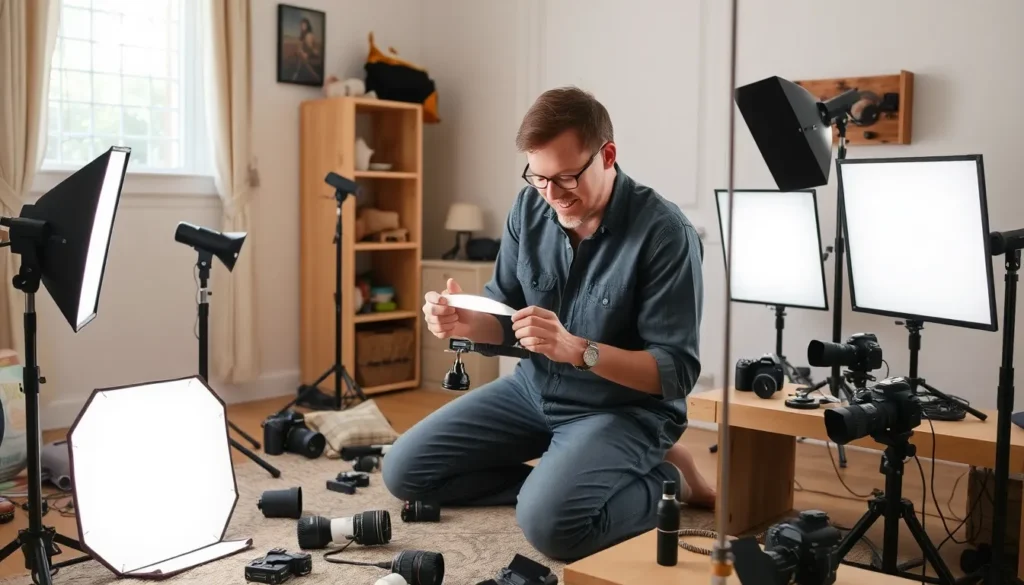In a world overflowing with stunning visuals, a photography portfolio template is your secret weapon to stand out. It’s like having a stylish outfit for your work—because let’s face it, first impressions matter. Whether you’re a seasoned pro or just starting out, a well-crafted portfolio can showcase your talent and personality, making potential clients say, “Wow, I need this person on my team!”
Table of Contents
ToggleWhat Is a Photography Portfolio Template?
A photography portfolio template serves as a structured framework for presenting photographic work. Such templates offer organization, ensuring that images and information flow cohesively. Photographers utilize templates to showcase their style, skill, and versatility, enabling potential clients to understand their unique aesthetic.
Typically, these templates include sections for an artist’s biography, contact information, and a curated selection of images. Each image represents a specific genre or theme, allowing viewers to grasp the photographer’s breadth of work. Designers often create visually appealing layouts that highlight images effectively, drawing attention without distraction from the photography itself.
Using a template simplifies the portfolio creation process, saving time while maintaining professionalism. Templates exist in various formats, catering to both digital and print needs. Photographers can customize these templates to fit their brand identity, tailoring colors, fonts, and layouts to suit personal style.
Having a well-structured portfolio template enhances a photographer’s ability to attract clients. An organized approach increases the likelihood that viewers will engage, appreciate the work, and ultimately make inquiries. Through the use of a clear template, photographers project professionalism, making a strong first impression that can lead to collaborative opportunities.
Benefits of Using a Photography Portfolio Template

Using a photography portfolio template brings several advantages that enhance a photographer’s presentation. Templates enable photographers to create a cohesive and visually appealing showcase of their work.
Streamlined Showcase of Work
A photography portfolio template organizes images in a structured way. Photographers can easily categorize their work by genre, style, or theme. Clear sections guide viewers through the portfolio, making navigation straightforward. Simplified layouts draw attention to the photographs themselves rather than distracting elements. Templates allow for quick updates and modifications, ensuring that the portfolio stays current. This adaptability supports showcasing new projects, enhancing the overall impression.
Enhanced Professionalism
Professionalism shines through when using a well-designed template. Consistency in design reflects a thoughtful approach to showcasing work. Customizable options align with a photographer’s brand identity, creating a personalized touch. A polished presentation fosters trust and credibility among potential clients. Templates often include essential sections like artist biographies and contact information, presenting necessary details in an organized manner. This structured format reinforces the photographer’s commitment to quality and professionalism, ultimately increasing client interest.
Key Features to Look For
When selecting a photography portfolio template, several key features enhance effectiveness and appeal. Focus on customization options and user-friendly design.
Customization Options
A versatile template provides various customization options. Different layouts, color schemes, and font choices enable photographers to express their unique style. Customizable sections allow easy incorporation of an artist’s biography, contact information, and genre-specific highlights. Flexibility in design ensures alignment with a photographer’s brand identity, strengthening market positioning. Templates should accommodate various image formats, ensuring versatility in showcasing work. With numerous options available, photographers can create a personalized, cohesive presentation that resonates with potential clients.
User-Friendly Design
A user-friendly design simplifies the viewer’s experience. Intuitive navigation allows easy access to different sections, which aids engagement. Clear layouts that emphasize images without distraction enhance visual appeal. Responsive designs ensure compatibility across devices, maintaining aesthetics on smartphones and tablets. Organized image categorization supports quick searches within the portfolio, showcasing versatility. Thoughtful placement of information contributes to an engaging flow, ensuring viewers remain captivated. Prioritizing usability fosters a positive impression, increasing the likelihood of client inquiries.
Popular Photography Portfolio Templates
Numerous photography portfolio templates cater to different styles and preferences. Simple layouts attract those who prefer minimalism, allowing their images to stand out. Dynamic templates offer modern designs with bold typography, perfect for photographers who want to make a statement.
Grid layouts provide structured presentations, ideal for showcasing a variety of works in an organized manner. Those who focus on storytelling may favor templates that emphasize narrative flow, guiding viewers through a curated selection of images. Additionally, templates designed for specific niches, like wedding photography or fashion, can appeal to photographers aiming to target their audience effectively.
Customizable features enhance the user experience, enabling photographers to adapt templates to reflect their brand. Flexible themes offer diverse color palettes, font options, and arrangement styles that personalize the portfolio. Some templates even come with integrated social media links, making it easier for potential clients to connect.
Responsive designs ensure that portfolios display beautifully across devices, accommodating viewers on desktops, tablets, and smartphones. Usability remains a crucial aspect; intuitive navigation enhances engagement and retention. Popular platforms like Squarespace, Wix, and WordPress provide a variety of templates, each suited for different needs and aesthetics.
Templates with built-in sections for artist bios and contact details streamline the process of portfolio creation. Clear organization promotes easy navigation by categorizing images by genre or theme. Portfolios showcasing versatility and distinctiveness are more likely to captivate potential clients, leading to increased interest and inquiries.
Tips for Creating an Impactful Portfolio
Select a cohesive theme that reflects personal style. Consider specific genres or subjects that resonate with what photographers love to capture. Organization plays a crucial role in guiding viewers through the portfolio, showcasing strengths effectively.
Highlight key images in a featured section to draw attention. Limit the selection to about 15 to 20 carefully chosen photographs that represent the best work. This curated approach emphasizes quality over quantity, ensuring that each image reinforces the photographer’s unique aesthetic.
Utilize high-resolution images consistently throughout the portfolio. Visual clarity enhances the viewing experience, allowing details to shine. Ensure that thumbnails link to larger views for each photograph when presented in digital formats.
Incorporate an engaging biography that connects with viewers personally. Briefly share the photographer’s journey, influences, and artistic vision to create a relatable profile. Including contact information in an easily accessible format encourages inquiries.
Integrate user-friendly navigation into the design. Simple and intuitive layouts enable viewers to explore the portfolio without distraction. Consider segregating images into categories, making it easier for potential clients to find preferred styles.
Update regularly to keep the portfolio current. Showcasing new work or trends signals a commitment to ongoing growth and adaptability. Seasonal changes or recent projects add relevance and keep the portfolio dynamic.
Seek feedback from peers or industry professionals before finalizing the portfolio. Constructive criticism often highlights areas for improvement. An external perspective can clarify whether the portfolio effectively communicates the photographer’s intended message.
A photography portfolio template is more than just a collection of images; it’s a powerful tool that helps photographers stand out in a competitive market. By utilizing a well-structured template, photographers can effectively showcase their unique style and skills while maintaining a professional appearance.
With customizable options and user-friendly designs, these templates streamline the portfolio creation process, allowing for easy updates and organization. A thoughtfully designed portfolio not only attracts potential clients but also fosters trust and engagement.
Investing time in selecting the right template and curating images can lead to exciting collaborative opportunities and a thriving photography career.



